Abstract
Cell surface structure plays a key role in Microcystis colony formation. The S-layer is a crystalline array of monomolecular proteins that constitute the outermost component of the cyanobacterial cell envelope. To date, no biochemical characterization of the S-layer protein in Microcystis has been reported. Here, we compared S-layer on the cell wall of the unicellular strain Microcystis aeruginosa PCC7806 with the colonial strain M. aeruginosa XW01. We observed crystalline S-layers in XW01 cell walls; however, similar structures were not observed in PCC7806. Sodium dodecyl sulfate polyacrylamide gel electrophoresis analysis revealed a thick putative S-layer protein band with an apparent molecular weight of 70 kDa extracted from XW01 cells, as well as an S-layer peptide fragment with the sequence ETYPLLAAPGAATDATR, similar to the translated product from PCC7806 unknown gene CAO89090.1. The amino acid composition of the translated CAO89090.1 product shared biochemical characteristics with those of bacterial S-layer proteins. Furthermore, a 1002-bp DNA fragment amplified from XW01 displayed 95% similarity with the CAO89090.1 gene, while the S-layer gene expression in XW01 was 36-fold higher than that observed in PCC7806. These data suggested that the S-layer protein plays a key role in Microcystis colony formation due to its significant contribution to cell surface hydrophobicity.




Similar content being viewed by others
References
Brookes J, Ganf GG (2001) Variations in the buoyancy response of Microcystis aeruginosa to nitrogen, phosphorus and light. J Plankton Res 23:1399–1411
Butler N, Carlisle JC, Linville R, Washburn B (2009) Microcystins: a brief overview of their toxicity and effects, with special reference to fish, wildlife, and livestock ecotoxicology program integrated risk assessment branch office of environmental health hazard assessment. California Environmental Protection Agency, Sacramento, pp 1–17
Golowczyc MA, Mobili P, Garrote GL, Abraham AG, De Antoni GL (2007) Protective action of Lactobacillus kefir carrying S-layer protein against Salmonella enteric serovar Enteritidis. Int J Food Microbiol 118:264–273
Hoiczyk E, Hansel A (2000) Cyanobacterial cell walls: news from an unusual prokaryotic envelope. J Bacteriol 182:1191–1199
Hynönen U, Palva A (2013) Lactobacillus surface layer proteins: structure, function and applications. Appl Microbiol Biotechnol 97:5225–5243
Ibelings BW, Mur LR, Walsby AE (1991) Diurnal changes in buoyancy and vertical distribution in populations of Microcystis in two shallow lakes. J Plankton Res 13:419–436
Jensen TE, Sicko LM (1972) The fine structure of the cell wall of Gloeocapsa alpicola, a blue-green alga. Cytobiology 6:439–446
Kessel M, Windhaber I, Cohen S, Baumeister W (1988) Three-dimensional structure of the regular surface glycoprotein layer of Halobacterium volcani from the Dead Sea. EMBO J 7:1549–1554
Laemmli UK (1970) Cleavage of structural proteins during the assembly of the head of bacteriophage T4. Nature 227:680–685
Messner P, Hollaus F, Sleytr UB (1984) Paracrystalline cell wall surface layers of different Bacillus stearothermophilus strains. Int J Syst Bacteriol 34:201–210
Messner P, Schäffer C, Egelseer EM, Sleytr UB (2010) Occurrence, structure, chemistry, genetics, morphogenesis, and functions of S-layers. In: König H, Claus H, Varma A (eds) Prokaryotic cell wall compounds: structure and biochemistry. Springer, Berlin, pp 53–109
Messner P, Sleytr UB (1992) Crystalline bacterial cell-surface layers. Adv Microb Physiol 33:213–275
Mobili P, Serradell Mde L, Trejo SA, Avilés Puigvert FX, Abraham AG, De Antoni GL (2009) Heterogeneity of S-layer proteins from aggregating and non-aggregating Lactobacillus kefir strains. Antonie Van Leeuwenhoek 95:363–372
O’Neil JM, Davis TW, Burford MA, Gobler CJ (2012) The rise of harmful cyanobacteria blooms: the potential roles of eutrophication and climate change. Harmful Algae 14:313–334
Pavkov-Keller T, Howorka S, Keller W (2011) The structure of bacterial S-layer proteins. Prog Mol Biol Transl Sci 103:73–130
Reynolds CS (2007) Variability in the provision and function of mucilage in phytoplankton: facultative responses to the environment. Hydrobiologia 578:3745–3768
Rachel R, Pum D, Šmarda J, Šmajs D, Komrska J, Krzyzánek V, Rieger G, Stetter KO (1997) Fine structure of S-layers. FEMS Microbiol Rev 20:13–23
Sara M, Sleytr UB (2000) S-Layer proteins. J Bacteriol 182:859–868
Schiewer U, Jonas L (1977) Wirkung unterschiedlicher NaCl-Konzentrationen auf die Ultrastruktur von Blaualgen II Synechocystis aquatilis. Archiv Fur Protistenkunde 119:146–162
Schultze-Lam S, Beveridge TJ (1994) Physicochemical characteristics of the mineral-forming S-layer from the cyanobacterium Synechococcus strain GL24. Can J Microbiol 40:216–223
Shi JQ, Wu ZX, Song LR (2013) Physiological and molecular responses to calcium supplementation in Microcystis aeruginosa (Cyanobacteria). NZ J Mar Freshw Res 47:51–61
Sleytr UB, Messner P (1988) Crystalline surface layers in prokaryotes. J Bacteriol 170:2891–2897
Smarda J, Smajs D, Komrska J, Krzyzánek V (2002) S-layers on cell walls of cyanobacteria. Micron 33:257–277
van Apeldoorn ME, van Egmond HP, Speijers GJ, Bakker GJ (2007) Toxins of cyanobacteria. Mol Nutr Food Res 51:7–60
Waterbury JB (2006) The cyanobacteria—isolation, purification and identification. Prokaryotes 4:1053–1073
Yang H, Cai Y, Xia M, Wang X, Shi L, Li P, Kong F (2011) Role of cell hydrophobicity on colony formation in Microcystis (Cyanobacteria). Int Rev Hydrobiol 96:141–148
Acknowledgements
The project was sponsored by the National Natural Science Foundation of China (31370217) and the project of Priority Academic Program Development of Jiangsu Higher Education Institutions (PAPD).
Author information
Authors and Affiliations
Contributions
M-SX did the electron microscopy and cell electrophoresis, W-BL determined the gene expression, W-WL did protein mass spectrum (MS), the other co-authors help them finished the experiments and preparing the manuscript. Because there is less information about the biochemical characteristics of cyanobacterial S-layer, we had been wondering for a long time whether or not the protein identified by MS was S-layer. Recently, W-WL verified the result by carefully repeated experiments and did bioinformatics analysis. I think her work play a key role in this article. So, getting the approval of co-authors, I finally decided to changed her to the first author.
Corresponding author
Electronic supplementary material
Below is the link to the electronic supplementary material.
Rights and permissions
About this article
Cite this article
Li, WW., Xia, MS., Li, WB. et al. Characterization of a Putative S-layer Protein of a Colonial Microcystis Strain. Curr Microbiol 75, 173–178 (2018). https://doi.org/10.1007/s00284-017-1362-3
Received:
Accepted:
Published:
Issue Date:
DOI: https://doi.org/10.1007/s00284-017-1362-3




